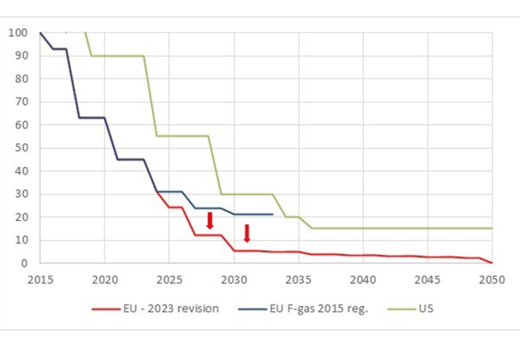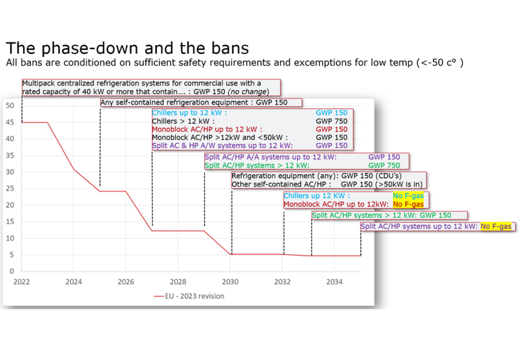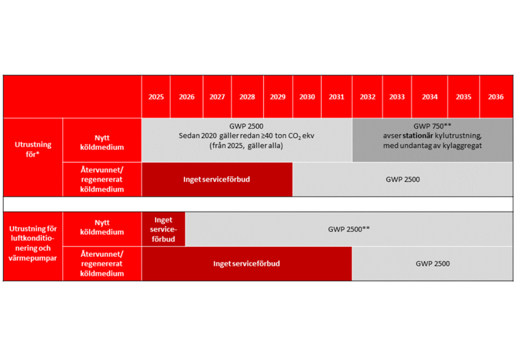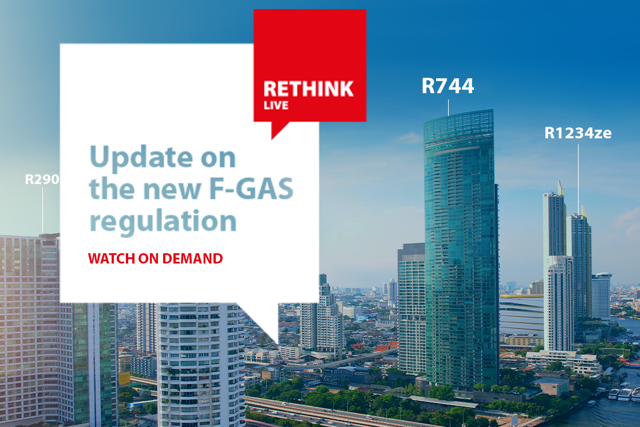Regulatory changes and the derived implications for the RACHP Industry are constantly increasing. The main driver for those changes are environmental concerns (health), resource efficiency and mitigation of climate change.
The EU F-gas regulation is considered a front runner, preceding the Kigali Amendment to the Montreal Protocol and going beyond the latter. The legal text as of November 2023 still needs final polishing and it is recommended to access detailed information in the official text.

The review of the EU F-Gas regulation:
The first EU F-gas regulation came into force in 2006 with the focus on containment and service. In 2014 the second version was agreed and with an additional phase down of high GWP refrigerants. In October 2023 the third version was finally agreed. The third version is an extremely ambitious regulation with a long term full phase out of F-gases. The EU and the US phase down of is illustrated in Figure 1 where the 2014 F-gas regulation is shown in comparison with the new 2023 agreed phase down. From 2025 the quota is reduced significantly compared to the previous phase and from 2030 the available amount of F-gases even for service is challenged.
The quota allocation mechanism has in principle not changed but the previously exempted Metered Dose Inhalers (MDI’s) are from 2025 included in the quota. Specific sub-quota allocations are made for MDI’s and the available amount for the RACHP industry is consequently reduced with a significant percentage which still has to be exactly specified. The allocation mechanism can be found in the Annex VIII of the Regulation.

The EU equipment bans:
The quota reductions are accompanied by Placing on the market Prohibitions (Bans). Compared to the last revision the amount of bans and the details are increasing. The overview can be seen in Figure 2.
Especially the bans outlined in figure 2 have been a big discussion theme during the review period. In the light of the aggressive quota reductions the long term consequence of having an application specific GWP ban is limited due to limited availability of refrigerants. However, it sends a clear signal to market on where to focus development efforts.
Export ban : From 2025 the F-gas regulation introduce an export ban for RACHP systems GWP ≥ 1000 provided that these systems cannot be placed on the EU market (see figure 2). This means that the date of the bans in Annex IV (figure 2) will set the date for the potential export limitations. There are not yet a practice on this restriction and it must still be verified if e.g. units designed for dual refrigerant use like R454B / R410A can count as a unit for the lowest GWP value.

Heat Pumps:
The EU ambitions on decarbonizing the heating sector implies a massive rollout of Heat pumps to substitute fossil fuel-based heating. The market for heat pumps is already in acceleration mode and there have been valid concerns regarding the availability of F-gases. Some important applications like small (<12 kW) A/W monoblock heat pumps will have GWP limits of 150 from 2027 and a full F-gas ban from 2032. Many of those units are today already using R290 so it is not expected to become a problem. Split systems < 12 kW also looks into a GWP limit of 150 from 2027 which can become a serious problem as raised by the industry associations. Small split systems has generally moved to the high pressure refrigerant R32 and a high pressure low GWP version is not available. Besides the specific bans, the small quota is seen as a potential threat to the roll out of Heat pumps. This has lead to a yearly assessment and a possible extra - but very limited- quota for the years 2025-2029.

Service bans:
Service bans has been strengthened. Also small refrigeration systems are from 2025 no longer allowed to use virgin refrigerant with a GWP >2500 . This will target old systems still relying on R404A. From 2032 the limit will be GWP 750. Service and maintenance of AC and HP equipment is likewise restricted with GWP level 2500 from 2026. It is important to notice that reclaimed and recycled refrigerant can still be used.
Conclusion: The EU has been experiencing HFC phase downs during the last 8 years. The regulation is considered a big success with measurable reduction in HFC emissions. With the new 2023 revised regulation even more strict phase down schemes are evident though the market need for refrigerants will increase due to the heat pump market acceleration. This will lead to an increased innovation towards applications using low and ultra low GWP refrigerants. Components for those applications are and will be available along the course of new needs for applications.




